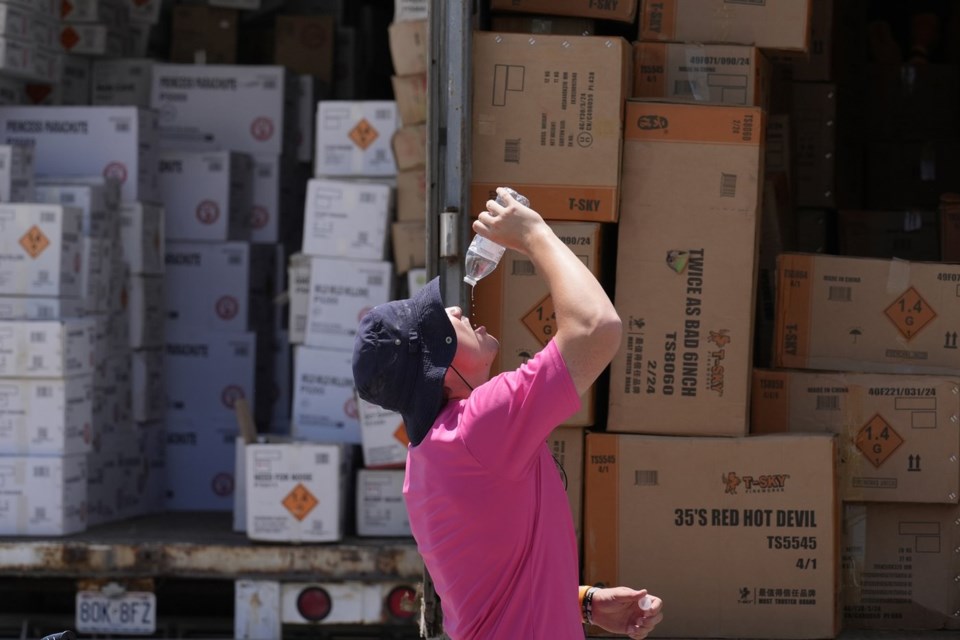Summer will make a dramatic entrance in the U.S. this week with a heat dome that will bring stifling temperatures and uncomfortable humidity to millions.
The heat will be particularly worrisome this weekend across wide stretches of Nebraska, Illinois, Wisconsin and Iowa, where forecasters are warning of extreme temperature impacts.
This will be the first stretch of true summertime weather for many from Midwest to the East Coast, said Tom Kines, a meteorologist at the private weather company AccuWeather.
“A lot of those folks have been saying, where’s summer? Well, buckle up, because it’s coming,” said Kines. The humid conditions will make places that exceed 90 degrees Fahrenheit (30 degrees Celsius) feel as much as 20 degrees hotter, said Kines.
Heat dome forming
A heat dome occurs when a large area of high pressure in the upper atmosphere acts as a reservoir that traps heat and humidity, said Ricky Castro, a National Weather Service meteorologist in Illinois.
According to the NWS Weather Prediction Center, daytime temperatures will be in the 90s Fahrenheit (30s Celsius) and overnight temperatures will only drop to the mid-70s Fahrenheit (mid-20s Celsius) from the Great Lakes to the East Coast during the heat wave that's expected to last into next week.
Moisture blown northward from the Gulf of Mexico is fueling the muggy weather, said Jacob Asherman, a Weather Prediction Center meteorologist. This influx of moisture is fairly typical during late spring and summer, he said. The Gulf, which shares borders with Mexico and the U.S., was renamed by President Donald Trump to the Gulf of America.
The heat will be widespread into next week. On Friday, Denver could reach 100°F (38°C), according to the weather service. Chicago temperatures could reach 96 degrees (36°C) on Sunday. On Tuesday, Washington, D.C., could see a high of 99°F (37°C) and New York Central Park could reach 96°F (36°C).
Several states in the Midwest could see dangerous temperature impacts over the weekend, according to a weather service measure that rates the risk from zero to four. Parts of Nebraska and Kansas will be in the highest category on the scale on Saturday, meaning that anyone without effective cooling or sufficient hydration could face health risks. On Sunday, Iowa, Wisconsin, Missouri and Illinois also see a category 4 rating.
High humidity makes it hard to cool down
Humidity is the amount of water vapor in the air, and the heat index is what the temperature feels like when the humidity outside is factored in, according to the weather service.
When humans sweat, it cools the body down because it absorbs and removes heat as it evaporates off the skin. The air is saturated with water on humid days, which makes it harder for sweat to evaporate. Hot and humid days can be dangerous when the body is unable to cool itself off and can exacerbate pre-existing health conditions and even lead to heat stroke.
Minimizing direct sun exposure, wearing loose and light-colored clothing, staying hydrated and spending time in air-conditioned spaces are ways to cool down during extreme heat, according to the NWS.
Some parts of the U.S., such as Phoenix, Arizona, are famously hot without the mugginess. Phoenix and nearby desert regions experience this so-called “dry heat” due to being located far away from large water bodies, mountains that block moist air masses and weather patterns that bring scarce precipitation.
Sweat evaporates faster in dry climates compared to humid ones. This can be dangerous because it is easy to underestimate how dehydrated you are, according to Johns Hopkins University and Johns Hopkins Health System.
Even the crops "sweat"
In places such as Iowa, crops can affect the humidity in summer months. Plants feel the effects of hot weather and some people in the Midwest are familiar with “ corn sweat,” which is when crops move water to their leaves and other surfaces so it can evaporate, according to the Ohio State University.
Madison County, Iowa, farmer Ryan Marquardt said corn sweat is “not as bad as a sauna, but it definitely would have a sauna effect. It’s humid in there (the cornfield), so you’re gonna sweat.”
Cornfield contributions to the overall humidity are much lower compared to the humidity winds carry from the Gulf, according to OSU.
___
Associated Press writer Jack Dura in Bismarck, North Dakota, contributed to this report.
___
The Associated Press’ climate and environmental coverage receives financial support from multiple private foundations. AP is solely responsible for all content. Find AP’s standards for working with philanthropies, a list of supporters and funded coverage areas at AP.org.
Isabella O'malley, The Associated Press



